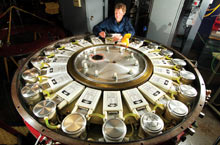Un peu de technique "en vrac"
DOCUMENTS DE BASE
La "Z-machine"
de Sandia ( Nouveau-Mexique ):
DOCUMENTS DE BASE
la fusion sans pollution ni radioactivité à portée de main!?

Fusion future? Sandia researcher Bill Fowler tests circuits on a device designed to produce large electrical impulses rapidly and repeatedly. Groups of such devices could be used to initiate nuclear fusion. Each element of the system features a pair of large capacitors and a switch arranged in a configuration that minimizes current-slowing magnetic fields.
| A new device could bring
high-yield nuclear fusion for generating electricity a step closer to reality,
according to researchers at Sandia National
Laboratories, in Albuquerque, NM. The technology, developed by Sandia
researchers in collaboration with the Institute
of High Current Electronics, in Tomsk, Russia, can deliver very brief
bursts of extremely large amounts of electricity and do it every 10 seconds
thousands of times in a row. The researchers still need to use the device
to produce a continuous series of miniature nuclear explosions that could
heat water and drive turbines in a fusion power plant.
The Sandia device stores energy in a group of large capacitors and releases it very quickly, in just 100 nanoseconds. A new kind of physical arrangement of these capacitors prevents magnetic fields from forming and slowing electrical current, a major problem with previous devices. But while acknowledging that the technology is an important advance for delivering pulses of power, several experts say a power plant based on such technology faces significant hurdles, not the least of which is building the plant sturdy enough to withstand the strong explosions going off every 10 seconds. While scientists have long known how to produce fusion--it's the heart of the hydrogen bomb--they've yet to find a way to harness that power in a power plant. Currently, the favored path to high-yield fusion that produces more energy than it consumes involves creating an ultrahot plasma and containing it within a magnetic field. An experimental machine designed to demonstrate such a concept is being built by a large international consortium in the south of France, and it's scheduled to be completed in about 10 years. (See "International Fusion Research.") But even if the project is successful, commercial-scale fusion power plants will still be decades away, as researchers will need to find ways to economically harvest the energy released by the fusion reactions. |
Meanwhile, researchers have been routinely
creating small amounts of fusion in the lab using a different technique,
called inertial confinement. Here fusion starts when a small pellet of
fuel is compressed by a burst of energy, which can be from different sources,
including lasers. At Sandia, inertial confinement is now done with the
Z machine, which uses electricity to create a burst of x-rays that
compress the pellet. While such machines are good for helping to simulate
nuclear weapons, they produce only a modest amount of fusion, releasing
only a small part of the energy in the fuel.
But with the new device, the researchers expect to be able to deliver more electricity than the Z machine can, increasing the temperature in a fuel pellet and causing more fusion to occur--potentially producing an explosion with significantly more energy than it takes to start the reaction. The device could also make it possible to ignite a fuel pellet every 10 seconds, providing a continuous supply of heat to make steam and drive a generator. To create this amount of fusion, the researchers will need to build many of these devices, linking them together to form modules, several of which would themselves be arranged around a central point, where the fuel pellet could be dropped and ignited. Such a system would deliver in an extremely short burst far more power than is created by all the power plants in the United States. Still, don't expect the Sandia technology to head to commercialization anytime soon. Even if money were no object, it could take 30 years to build a system, says Keith Matzen, director of pulsed power projects at Sandia. Others think the engineering challenges involved in harnessing rapid series of large explosions are likely to prove just too difficult. With the new device, says Ian Hutchinson, professor of nuclear science and engineering at MIT, the Sandia and Tomsk researchers have scaled a 500-foot hill. The work they've yet to do is the equivalent of a 25,000-foot mountain. Several other researchers concur, noting that the Sandia researchers must also demonstrate that the system can produce the levels of fusion that their models predict. |